Hello again everyone. Things here in Iraq are still going well. In fact, this week, I had the opportunity to tag along with some Army engineers.
One difference between Air Force and Army engineers is that the Army engineers use explosives to breech doors, or in this case to bring entire buildings down. It worked out as a great joint training opportunity. The Army conducted their training and we in the Air Force provided support. I was there as an observer and to help coordinate Air Force support. The overall goal was to use a number of small charges to teach what damage different types of charges cause and to eventually completely destroy the building. It was a condemned facility that we no longer needed.
Here’s what the building looked like at the beginning (remember what it looks like here … it won’t stay this way very long).
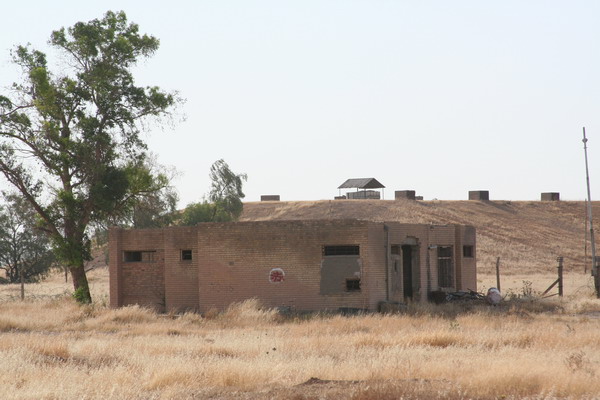
As most male children will agree, it’s fun to watch things go boom. Here is the first of the day.
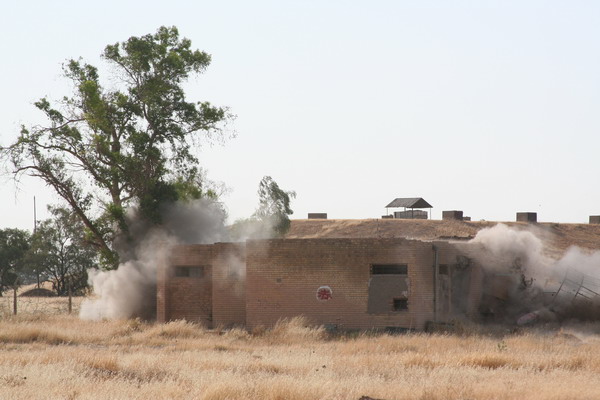
This is the damage that the explosive charge and the over-pressure caused by the explosion wreaked on the building from that first blast.
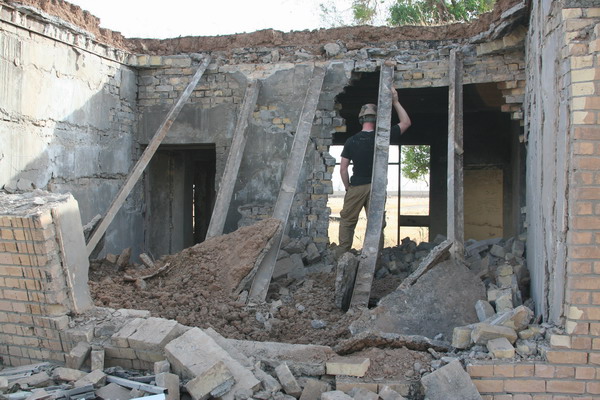
This is a perfect example of what a breaching hole looks like. The idea is to use an explosive charge only large enough to create a man-sized hole to enter through, not bring the whole building down.
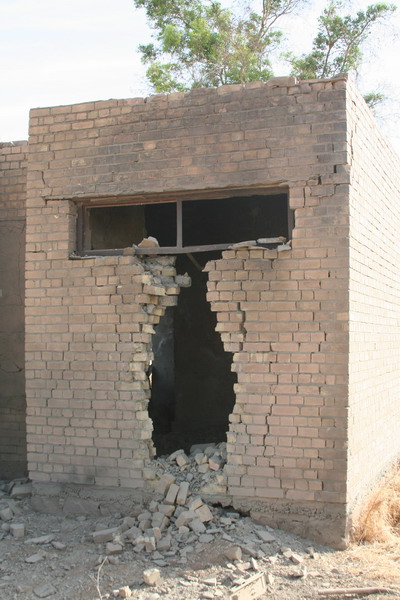
Here is another charge being built.
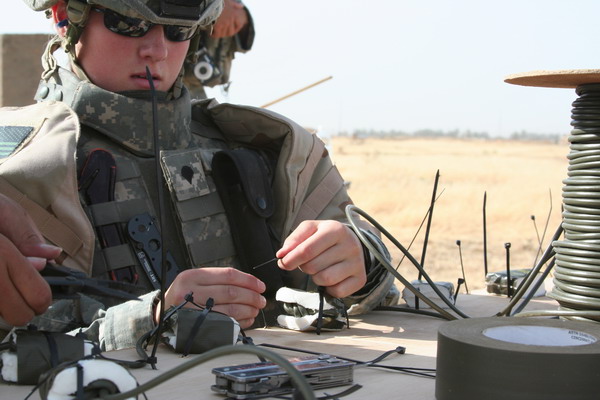
The finished product, proudly on display and ready to be placed.
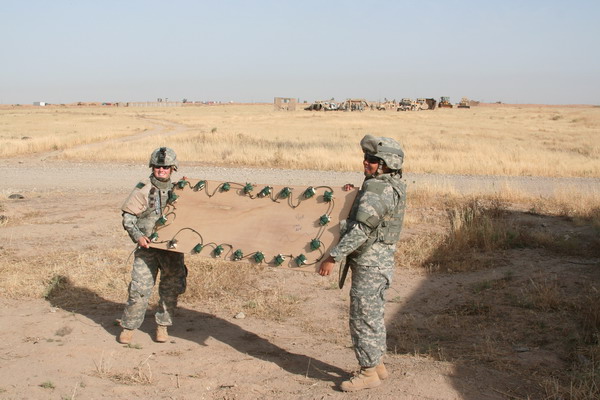
Here it is in place and the fuse being lit.
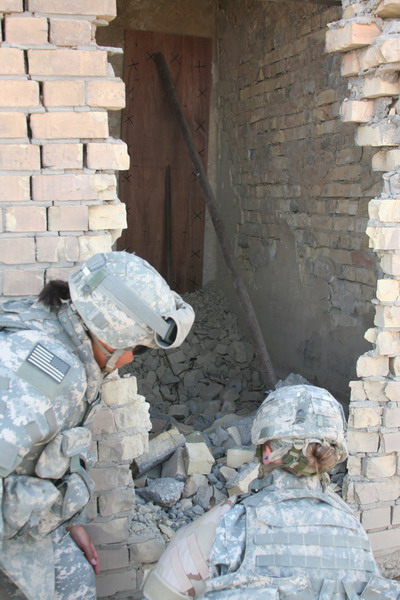
Boom.
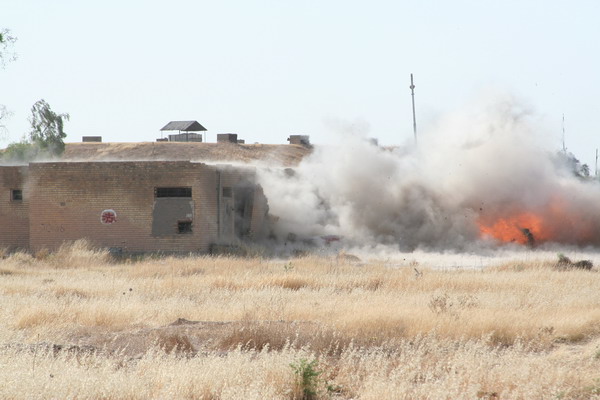
The base videographer, Roidan, was on site to document the event as well.
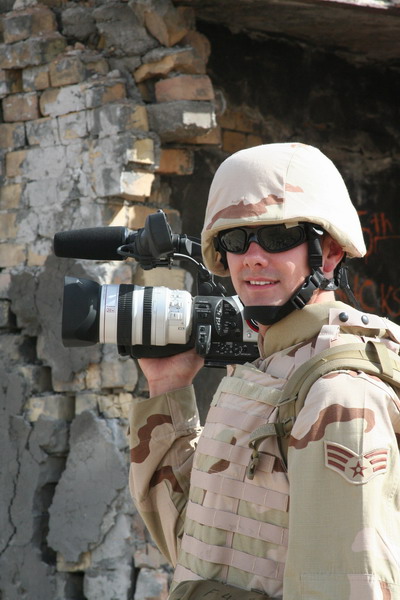
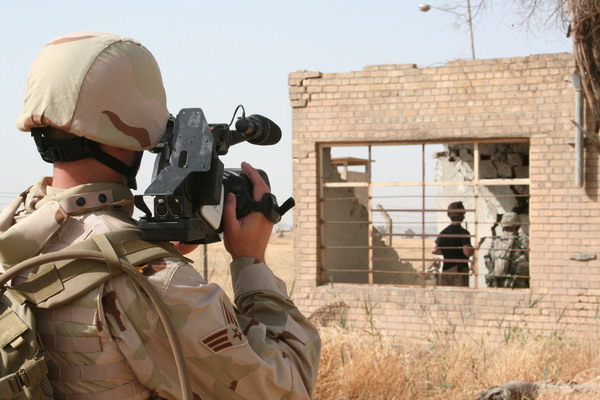
This is an interview with the Engineer Company First Sergeant, who was the main force in setting up this operation.
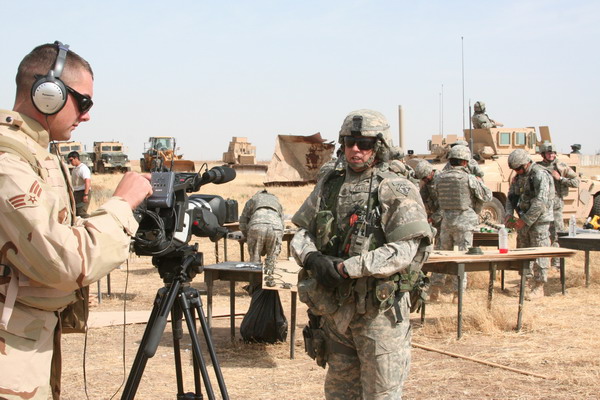
Since it took a while to inspect the damage of each blast and place the next one, the soldiers took refuge from the heat in their vehicles.
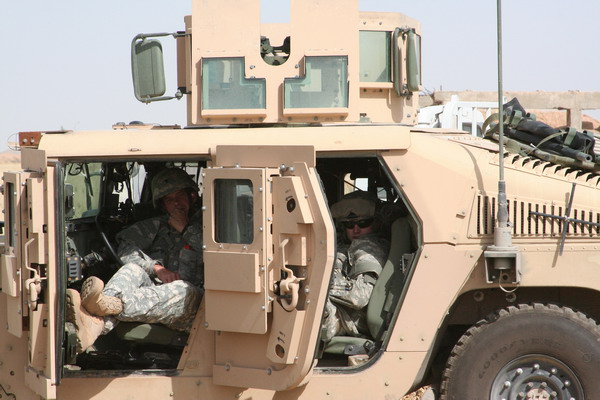
Lighting the fuse … Ready.
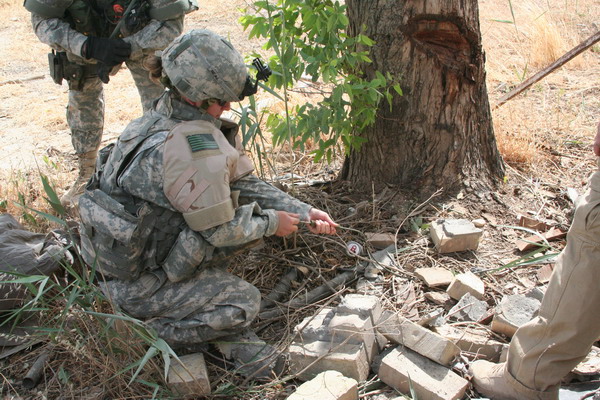
Set…
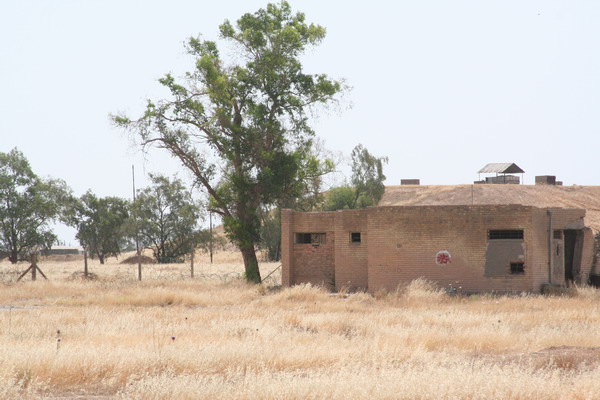
Boom.
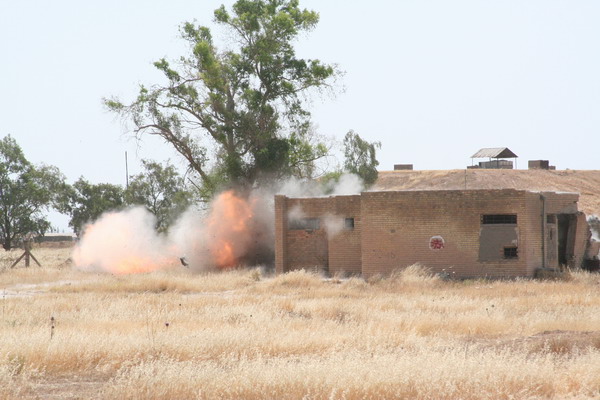
Here I am standing on the partly destroyed building.
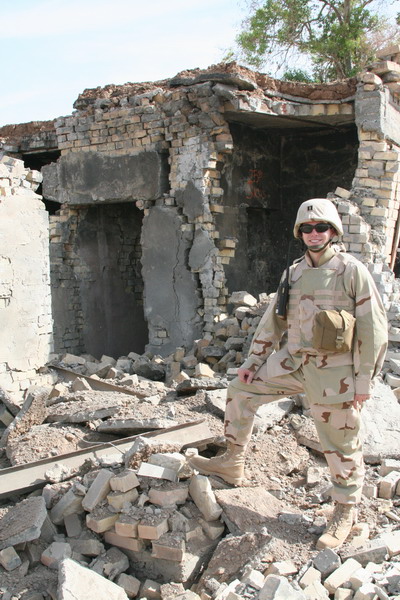
Setting another charge.
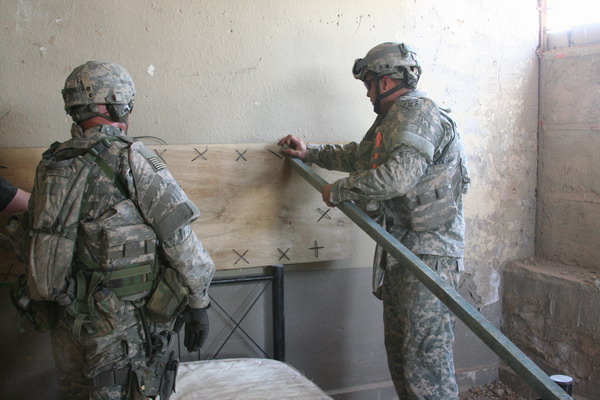
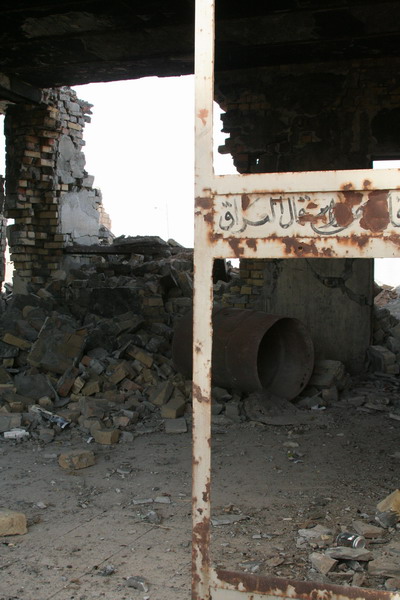
Ready to blow again.
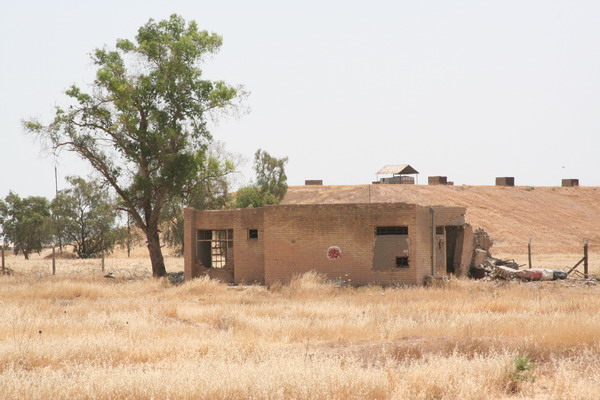
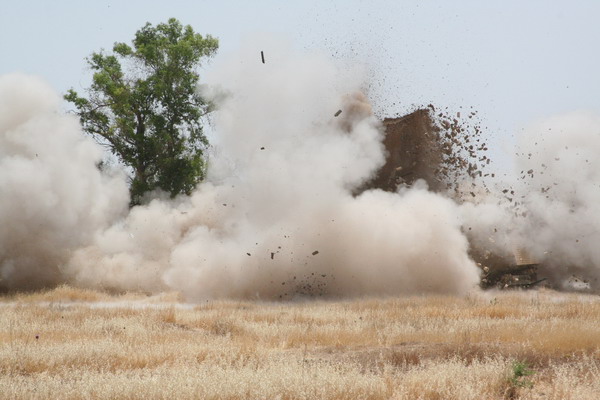
It’s starting to look more like a pile of rubble than a building. A few more blows and there will be nothing left.
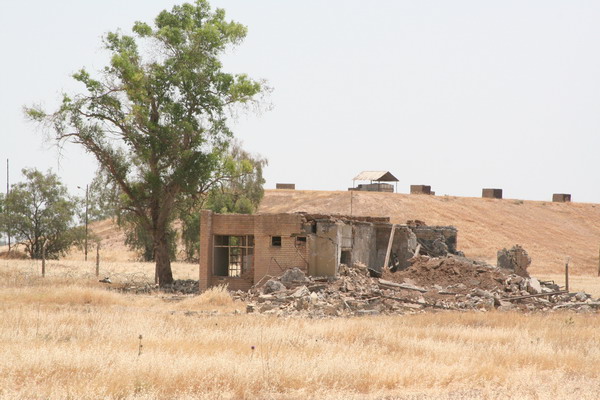
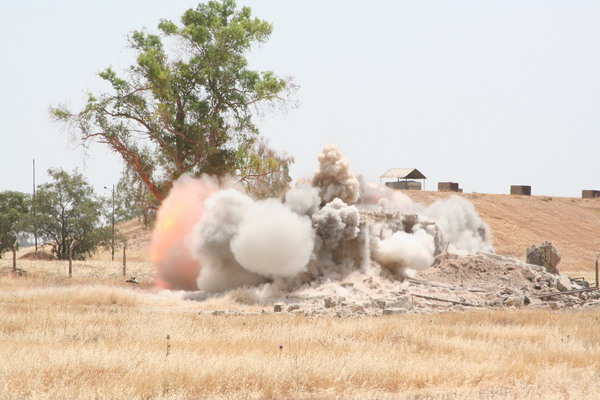
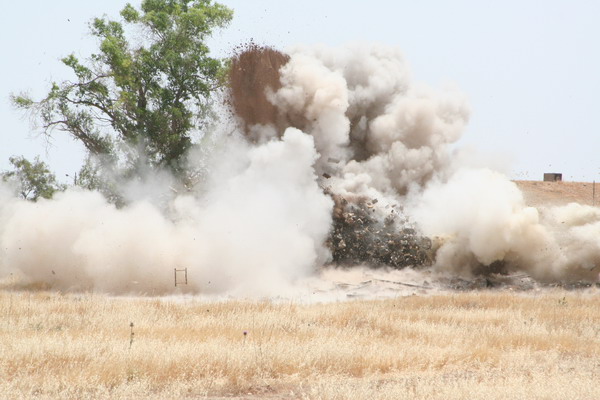
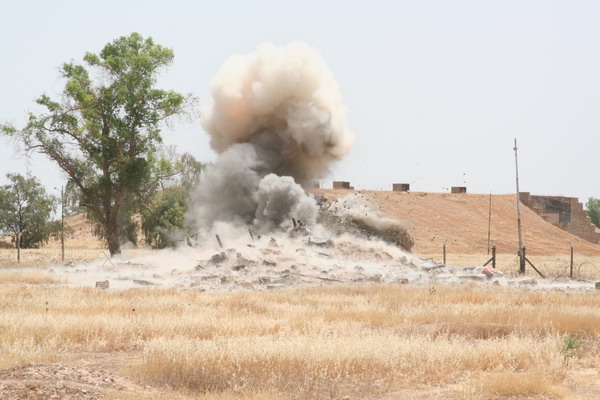
After the day’s explosions. This is all that was left.
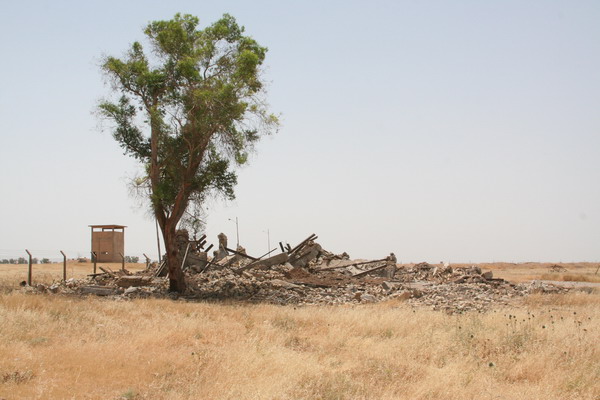
It was a success for everyone involved.
–Jim
Month: May 2007
Deployment begins…
This begins by deployment to Iraq. I have decided to continue updating the website as more of a traditional blog, instead of a travelogue.
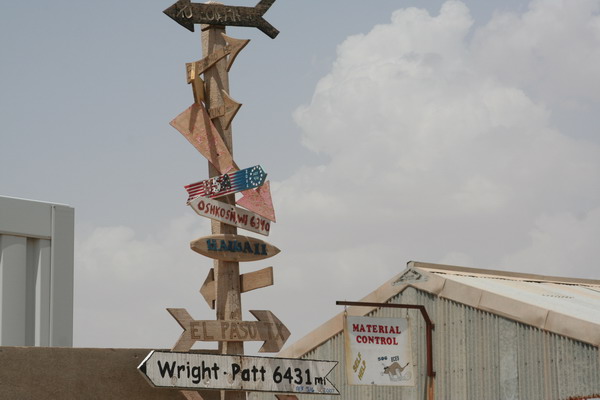
Hello again everyone. Well, I have arrived at my new home for the summer/fall. Even though I have deployed before, it’s certainly a bit of an adjustment to re-acclimate to the deployed environment.
Now, let me fill you in on some of the details that have taken me from Germany to Iraq.
The US military is second to none in its ability to transport personnel and equipment from one place to another. However, it was still a very long process to gather all the requisite gear, process the right documents, attend briefings to make sure Anna and I had all the information we needed, and finally to assemble that gear and start the journey to our final destination. All told the transportation alone took three and a half days, and Germany is only two time zones away. I point this out to imagine how far we, as a military, have come. A comparable trip only a half century ago would have taken much longer.
Let me explain some of the logistics involved. We were transported by bus to an air terminal. We waited there for about 8 hours, before going back home for the night (the plane had been delayed). It was nice to be able to go home again and spend another night with Anna. It actually made leaving a little more palatable for both of us. The next day, we repeated the process, except this time, the plane actually arrived. However there was more maintenance problems, so we were delayed again, but eventually left.
One of the little know facts about US Air Force transports is that we utilize something called the Civil Reserve Air Fleet. That is made up of civilian passenger and cargo aircraft to supplement military transports when the demand exceeds the military’s intrinsic capability. As of the end of last year, there were 39 carriers and 1,379 aircraft enrolled as part of the Civil Reserve Air Fleet. That translates to over $2.5 billion in contracts to civilian aviation. For example, the plane I flew over on was an ATA jet, filled with Airmen in their desert camouflage uniforms. Quite a site to see.
Anyway, after about a 4 hour flight, we arrived in Qatar (where I spent a significant amount of time on my last deployment). There, we found out our follow on flight to Iraq was a day later, so we got to enjoy the transient lodging accommodations. We (the five guys going with me) were in a large tent filled with about 50 bunk beds. Fortunately, we were the only ones there. Since we got in at about 3 o’clock in the morning, I decided to enjoy sleeping in a little bit. After wandering around during the day (and saying hi to a couple friends deployed there … hi, Brian and Katie) we gathered all our gear up and went back into the passenger terminal to wait. I think we ended up waiting for about 7 hours (more plane troubles), but eventually loaded up into a C-130. For those who have never had the pleasure of traveling by C-130, the mighty and venerable Hercules, I will explain a little of what it’s like: imagine cramming in to sit on cargo netting. Your neighbor on either side sitting so close that your shoulders are touching. To top it off, the people sitting across from you, are so near that you have to overlap your knees. So, there we sat with all of our gear on (Kevlar helmets and ballistic body armor) for our 4 hour flight. Unfortunately it seemed to be a trend, and we had to make an unplanned stop in Kuwait. Not to worry though, it was minor and we were back in the air in no time (well, actually, it was about 2 hours). Eventually, we arrived in Kirkuk, our final destination the next morning. The Airmen we were replacing met us at the airport and looked VERY happy to see us.
I spent the next several days learning as much as I could. Soon though, the Airmen we replaced headed out the door to return home. They had spent four months here and were ready to go. That brings up another interesting point. At this base, we have many joint operations with the Army and Iraqi Air Force (along with their American transitional team). So, it’s interesting to notice that the Air Force deploys its Airmen for somewhere bewteen 4 and 6 months. While the Army keeps their soldiers here for a year, but the ones here right now just found out they have been extended to 15 months. Even so, the morale of the base is remarkably high.
What do I do here? Well, without getting into too many specifics, I help manage the base’s infrastructure with maintenance, repair and minor construction. However, it’s the team of guys here with cross functional expertise to make that a reality. We in the Air Force, with the exception of our explosive ordinance disposal teams, stay exclusively on base to manage the base and our Air Force mission. It’s the Army soldiers who go out to patrol / protect the city of Kirkuk.
Kirkuk is a fascinating history and although I can only see it over the wall or through a fence, let me share a few of its highlights.
Kirkuk is in the Northern section of Iraq (about 240 kilometers north of Baghdad).
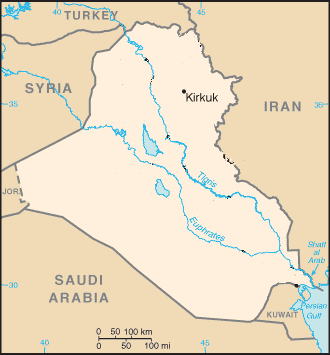
The approximately 750,000 residents of Kirkuk are very ethnically mixed among Kurds, Arabs, Assyrians, Turkmen and Armenians (plus both Shi’ite and Sunni Muslims live here). The big debate is the upcoming referendum in November or December 2007. It proposed, under the new Iraqi constitution, to have Kirkuk decide if it wants to join the Kurdistan Regional Government. That means that the 120,000 people forced out by Saddam after the 1991 Gulf War, who were replaced by tens of thousands of Arabs in an attempt to “Arabize” the city/region, could return home. That will effectively swing the balance of power toward the Kurdish ethnicity.
Another interesting, non-political fact about Kirkuk is that it is believed to hold the Tomb of David, a biblical prophet. But, there are at least two other sites that also claim to hold the tomb of Daniel. Probably the most famous story of Daniel is when he was cast into the lion’s den, but walked out, untouched.
So, hopefully, that gives you a little flavor of the area I am staying in and doing my part to help stabilize.
So, until the next post.
–Jim
The Black Forest
As the final leg of our adventure, we decided that a little relaxation was in order.
So, we drove north, through the fairy tale land of Germany’s Black Forest. This forest is known for Cuckoo clocks, ham, grandfather clocks and is the setting for many of the Brothers Grimm fairy tales.
As we drove (and got out to hike around a couple times), we thought for sure we would see Hansel and Gretel crossing the road. Perhaps Rumpelstiltskin would be sitting next to the large tree, just over there… but alas, it was not to be. We didn’t meet any of those characters, merely an enchanted forest.
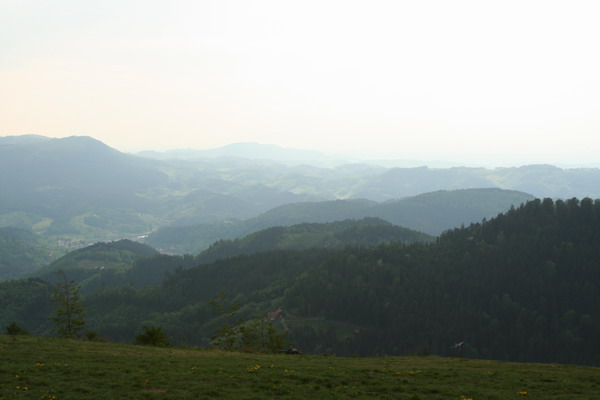
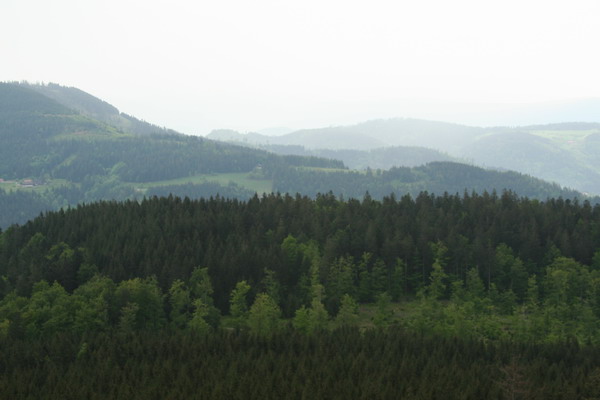
We also stopped by this small lake called Mummelsee. Legend has it that there is an evil sea king who lives in this deep lake. However, it’s only 17 meters (55 feet) deep and we didn’t see anything remotely evil, except perhaps the large parking lot that holds buses containing streams of tourists during the high season.
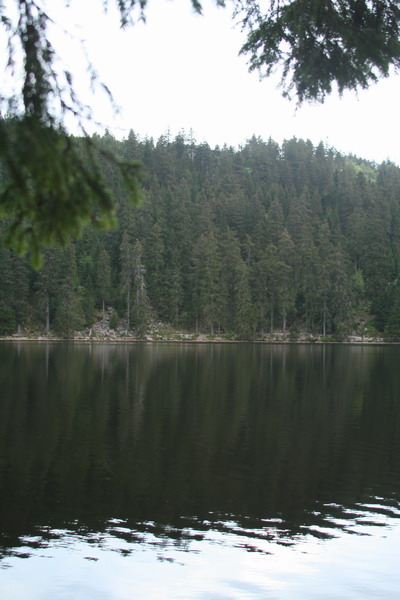
Although Mürren was very low-key, there are few places to relax better than a stay in the German city of Baden-Baden. As I type this, I am in a large square, using ubiquitous wi-fi to access the site. There are people all over, cafes serving coffee and food and a fountain of mineral water bubbling over rocks. It’s that mineral water that we came to enjoy. This city has been known as a bath town since Roman times. There are naturally heated springs flowing underground and two large spas have tapped into them.
Purportedly, former President Clinton said “Baden-Baden is so nice,
that you have to name it twice” after he and Hillary visited. And, while we wouldn’t rely on water to cure any ailments, Mark Twain was so enamored after his time here, he said, “I firmly believe I left my rheumatism in Baden Baden. The town is welcome to it. I would have preferred to leave something catching, but it was not in my power.”
We began our visit here with a stroll along the Lichtentaler Allee and popped into this rose garden. While it’s a little early still for the roses, it’s still pretty.
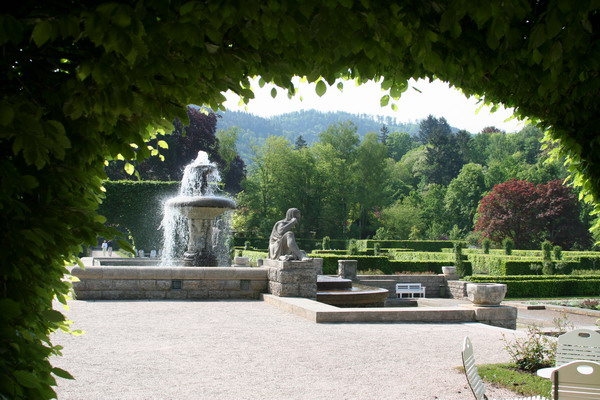
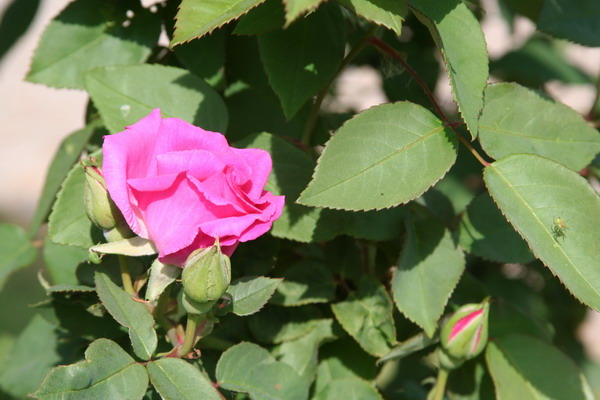
Farther down the Lichtentaler Allee, we found more flowers…
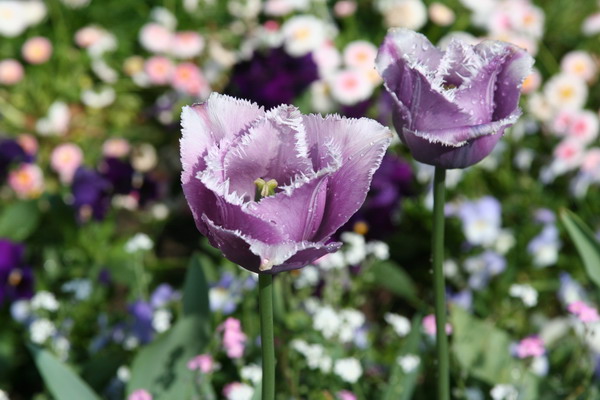
And some aquatic friends.
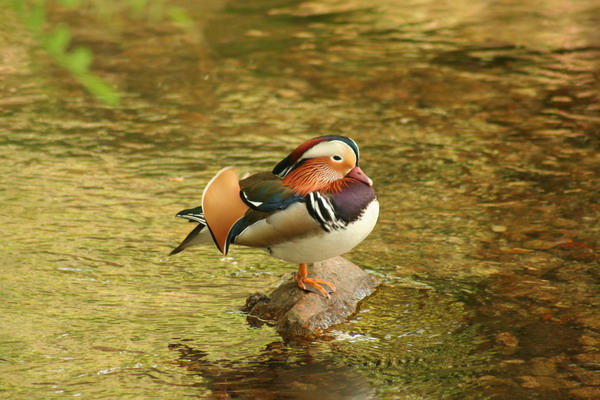
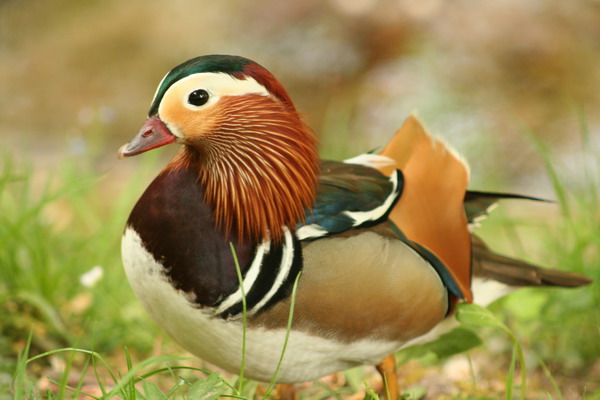
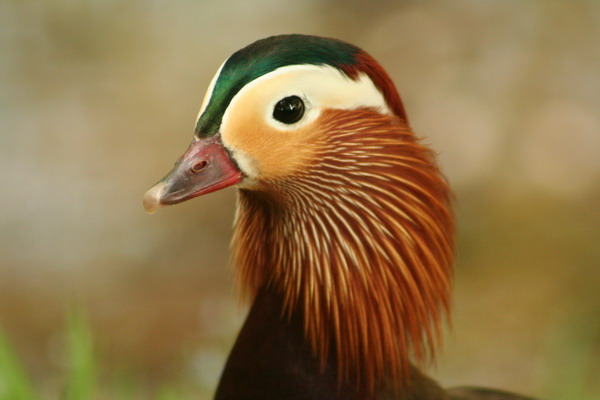
Now, back to the baths. Although I don’t have any images to share with you all, we did go to both of the major baths, the Friedrichsbad Roman-Irish Bath and the Caracalla Therme Baths. Both are supplied by naturally heated underground mineral water. They were very different, but both were relaxing. Our favorite was the Friedrichsbad Roman bath, which takes bathers on a sixteen stage journey of cleanliness and relaxation in an elegantly decorated building:
1. warm water shower
2. warm air bath 54 C (129 F) (also known as a sauna)
3. hot air bath 68 C (154 F)
4. shower again
5. soap and brush massage (if you pay the extra charge, which we did)
6. shower … again
7. thermal steam bath 45C (113 F)
8. thermal steam bath 48C (118 F)
9. thermal full bath 36C (97 F)
10. thermal whirl pool bath
11. thermal kino-therapeutic bath (read: lots o’ bubbles)
12. shower one last time
13. cold water immersion bath 18 C (64 F) and let me tell you, this one was cold, but surprisingly very refreshing!
14 dry off with a warm towel, which feels divine after the cold water
15 application of moisturizing cream (to reverse the raisin process)
16. rest area, where for 30 minutes you are bundled up cocoon-like in blankets (and most people doze off for a while).
After that experience, we wandered the town center on a cloud. It was a great bathing experience. This morning, we also sampled the mineral waters in Caracalla. It was more of a recreational facility with a number of baths. However, there was no focus on the relaxation. The best part for us was the variety of indoor and outdoor pools. It even had a high speed lazy river, that was like floating on a giant bottle of mineral water.
So, after our relaxing stay in the Black Forest, we returned home. Unfortunately, this will have to be our last trip together for a while. I am headed out to Iraq next week for about 6 months. I don’t know if I will continue to post, but either Anna will post her continued travels, or if nothing else, this winter, we will have more joint trips to share with you all.
So, until then…
–Jim
Switzerland Part 2 — Mürren
After our adventures in the Interlaken Valley, we moved our base camp further up the mountain to the village of Mürren.
This magnificent little village is only accessible by hiking trail and train. Since we had a bit of luggage (including the computer I’m typing on), we opted for the easier, but still picturesque train.
The period after Easter until mid-May is in between the winter and summer seasons. So, most shops (and people) are closed/gone on holiday. Fortunately, in early May, some places are opened back up. Such was the case for the B&B where we stayed. The owner of this lovely place, Denise, opened a day early. It was the perfect location and if you decide to trek to Mürren, we highly recommend the Chalet Fontana.
Since there are no cars in the town (except a couple work trucks that seemed to be everywhere at once!), hiking was the plan for our time there.
Mürren is on the east side of the Lauterbrunnen Valley and offers a great view of the Eiger, Mönch and Jungfrau mountains on the other side of the valley. Although this is a resort town, we virtually had the place to ourselves. The hiking trails were very easy to navigate and gave views that are second to none. As you can see here, at 1,650 meters (or 5,400 feet), it is often already above the clouds.
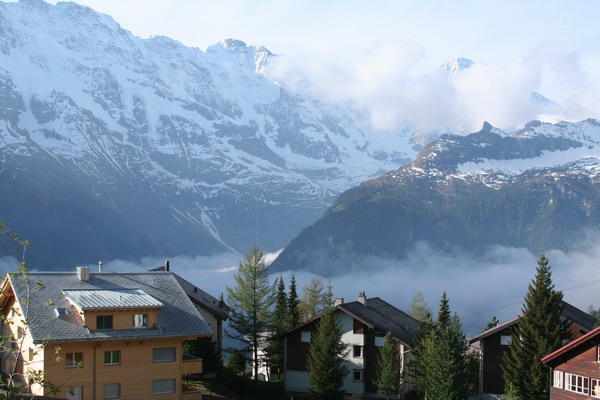
Here’s a perspective of Mürren as we emerged from the trees.
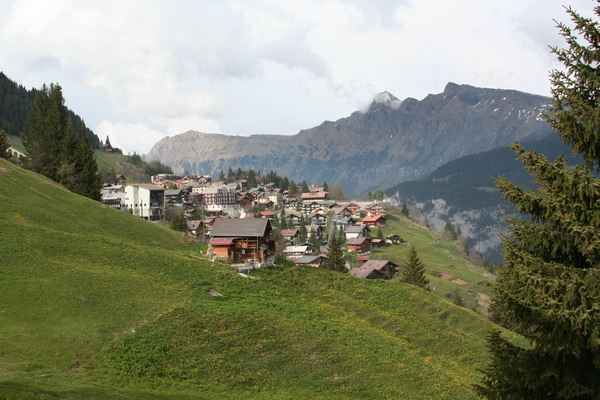
Unfortunately, there wasn’t an abundance of wild fauna, but there were quite a few domestic and relatively tame ones for our viewing pleasure.
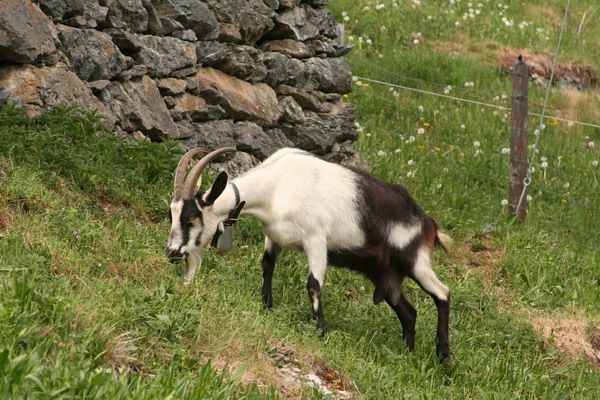
Here we are on another hike. This is one of those times I wished I brought a tri-pod with (or that there were other people on the trail). So, I used a small pile of rocks instead. Anna makes a nice blond pine tree, don’t you think?
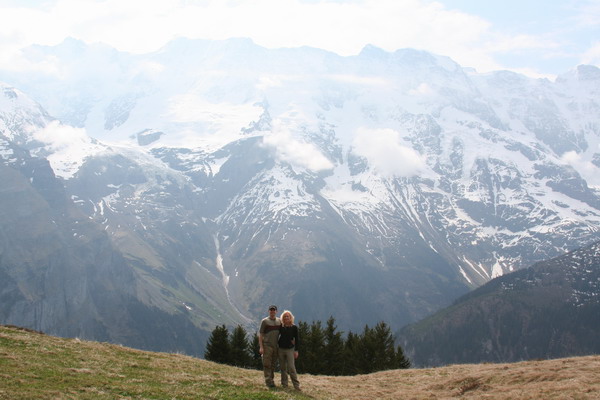
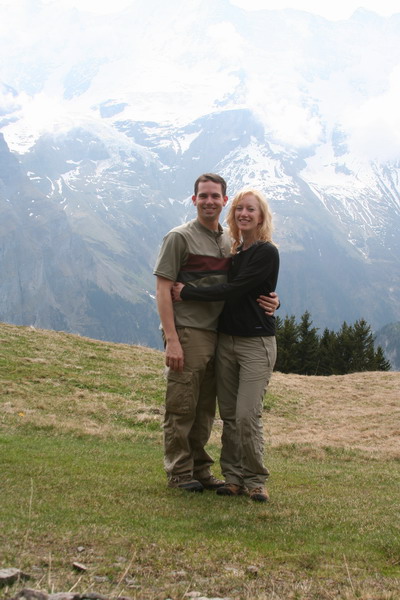
Here’s the view back down to Mürren.
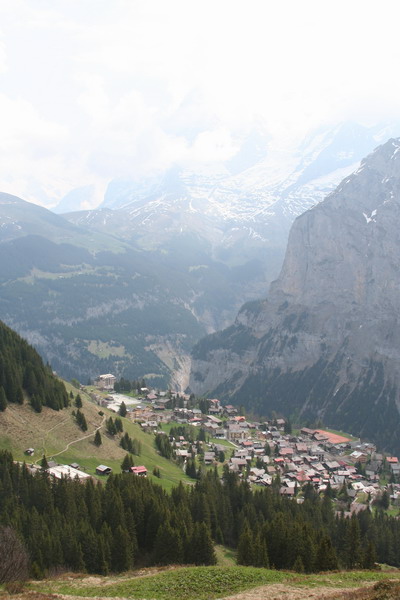
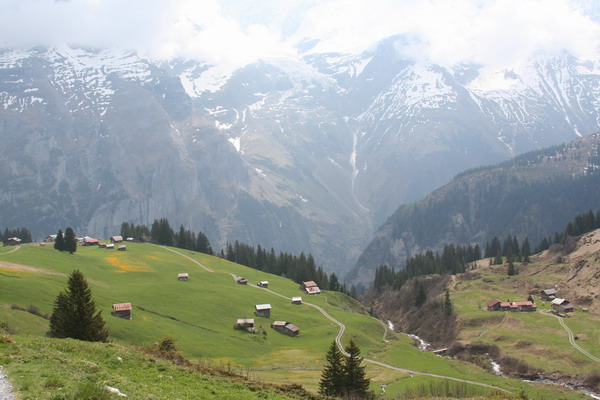
The mountain wild flowers were very pretty too.
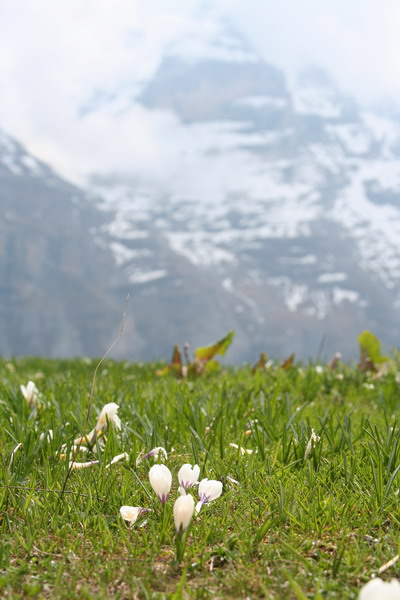
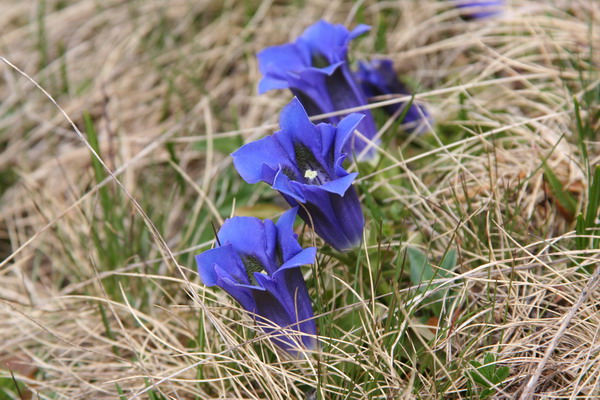
The plan for this hike was to go all the way up to the gondola station, Birg (2,677 meters or 8,800 feet), then ride that up to the peak of the Schilthorn (2,970 meters or 9,750 feet).
However, for those who have accompanied us on hikes in other locations you know that I can be a little zealous in my hiking goals… This time though, Anna talked some sense into me. The clouds covered Birg and she said she saw lightning. While I didn’t see the lightning myself, I trusted her judgment and reluctantly acquiesced, so we headed back down the mountain.
Anna wanted this picture as proof that it was indeed bad weather…
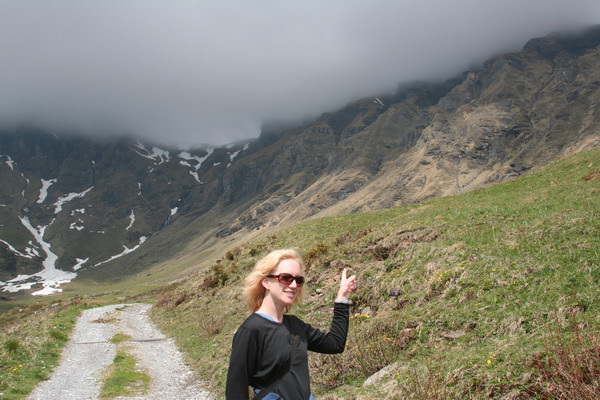
The next day, it had cleared up sufficiently to actually see Birg and the Schilthorn Peak. Instead of retracing our hike to re-attempt the peak, we opted for the easier gondola. Again, since it was early season, the ticket prices were reduced (although still expensive).

On the peak there is a revolving restaurant called the Piz Gloria. It was completed in 1968 and it’s claim to fame is that before it opened to the public, it was used in the James Bond film, “On Her Majesty’s Secret Service” in 1969. For those who have actually seen the film (neither Anna nor I have), it was the one where George Lazenby played 007 (after Sean Connery and before Roger Moore). The view, although partly obscured by the haze and clouds was still beautiful.
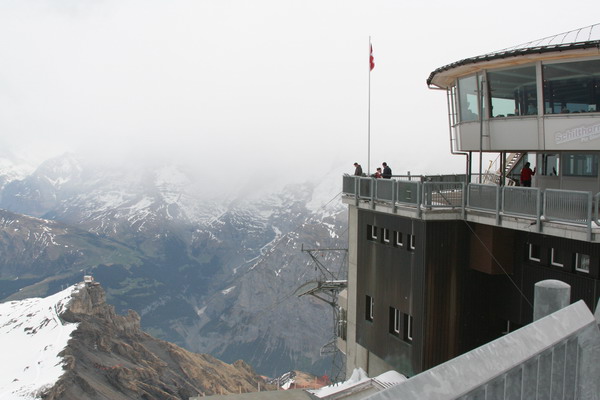
Here is the view looking back down at Birg. You can see there was a bit of snow on the trail. As it has been in Germany, this spring has been exceptionally warm. Denise told us she skied down from here just two weeks before. Now, there’s hardly any snow left. Perhaps next time we come back, we’ll come to ski (and hike).
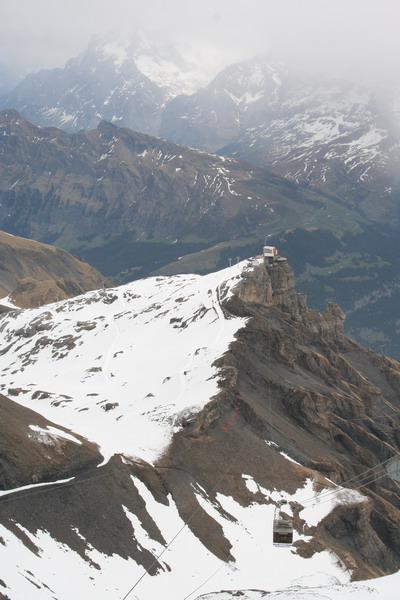
Yet another view of Mürren. I couldn’t help myself, it was just too cute.
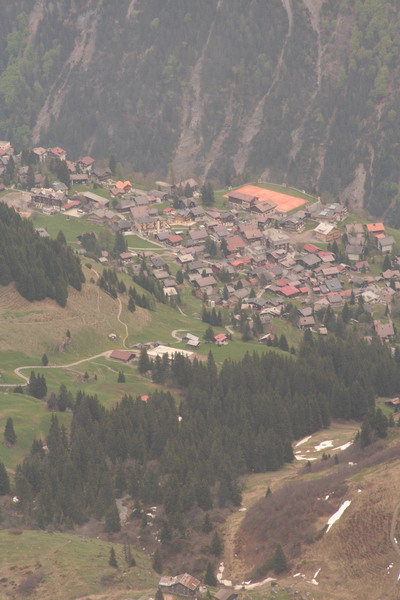
Here are a few images from yet another hike. This time down past the smaller (even more remote) village of Gimmelwald. It has been saved from further development by its designation as inside an avalanche zone.
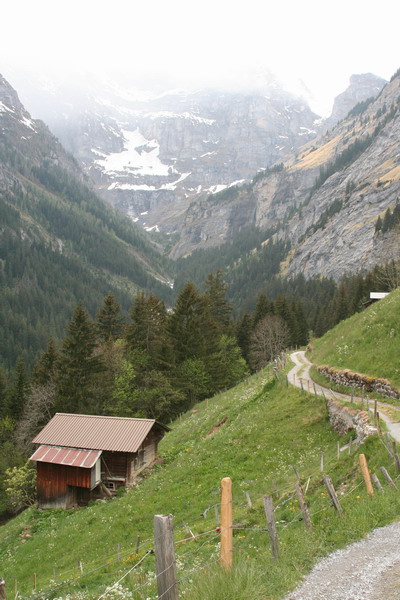
There were pretty wild flowers here too.
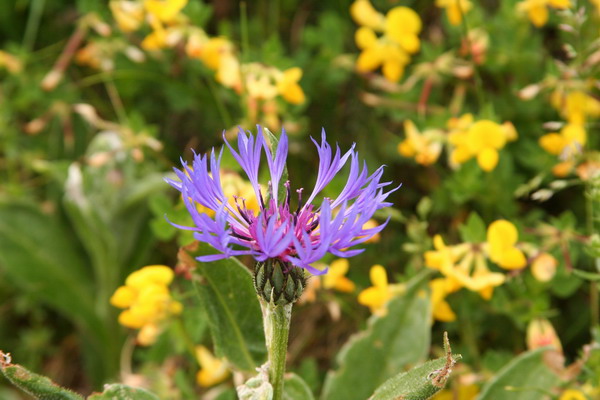
This waterfall was Anna’s favorite.
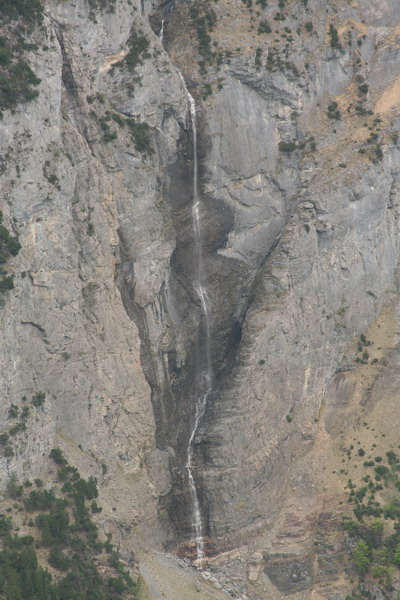
Trümmelbach Falls was my favorite, but this one was my second favorite.
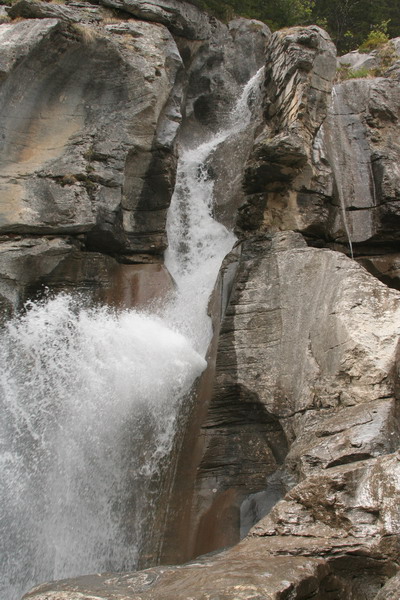
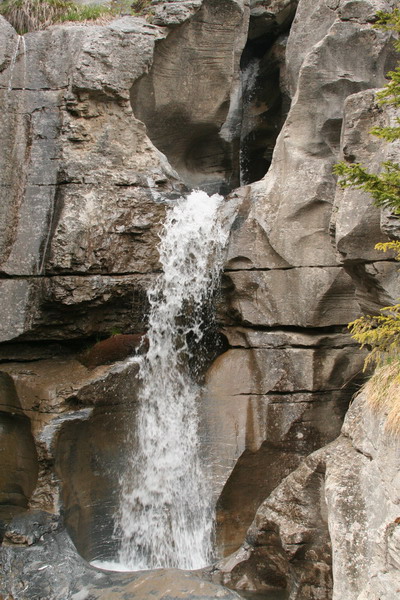
Swiss architecture all over the country was beautiful, but in the mountains, the combination of synthetic and natural was amazing.
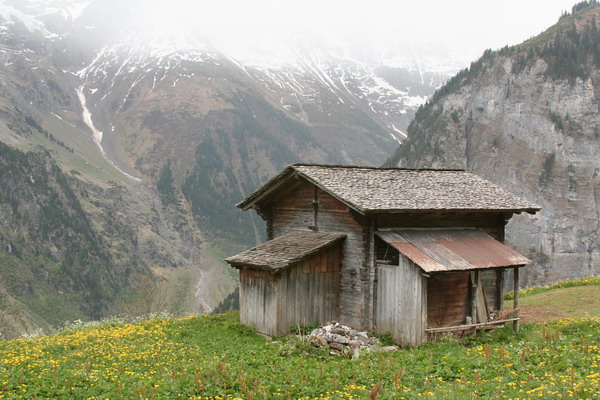
The next morning, we packed up our bags and headed back down on the train. We really enjoyed our time back in the mountains. It was hard to leave, but we are excited that the Alps are only a (relatively) short car-ride away.
Up next is a bit of relaxation in the bath town of Baden-Baden on the edge of the German Black Forest.
–Jim
Switzerland — Interlaken adventures
The past few days, Anna and I have enjoyed an adventurous trip to Switzerland. We picked the city of Interlaken for the magnificent landscape and the variety of adventure sports it offered. The first day, we got acquainted with the city.
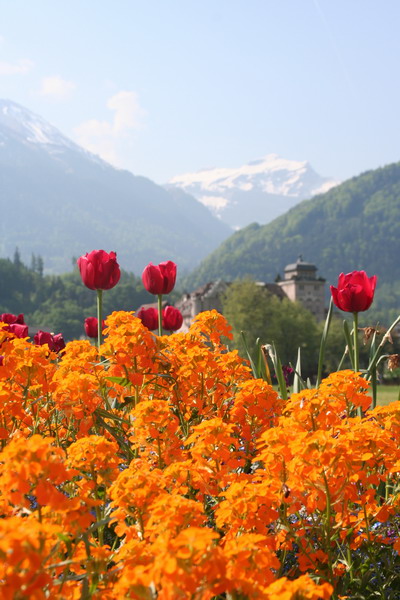
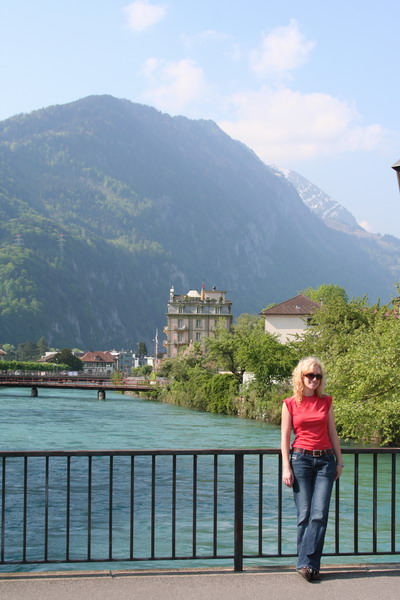
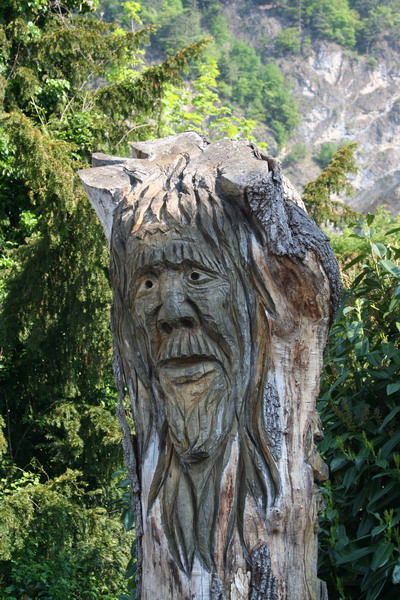
Next, we decided to see what type of adventure we could find. We heard that the paragliding was especially nice.
This is our group. To paraglide with tourists, you have to have a commercial rating (much like an airline pilot, but with less flight time required). So, when we got to the top of the mountain, we had the privilege of choosing our pilot. When was the last time you got to have a lineup of pilots and you choose the one who seems the most qualified?? 🙂 Fortunately, Anna and I chose wisely and we had very knowledgeable and skilled pilots to accompany us on the journey down to the valley floor.
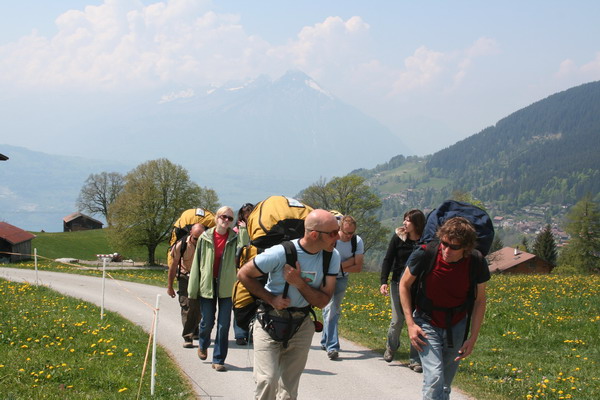
One of the reasons paragliding is safer than sky diving is that you can inspect the chute and lay it out in the right position before you
leave the ground. When you are free falling at 120 MPH, you don’t have the same luxury. Plus, the risers can become entangled and not let the chute fully inflate. With this, all of that is avoided by a simple pre-flight inspection.
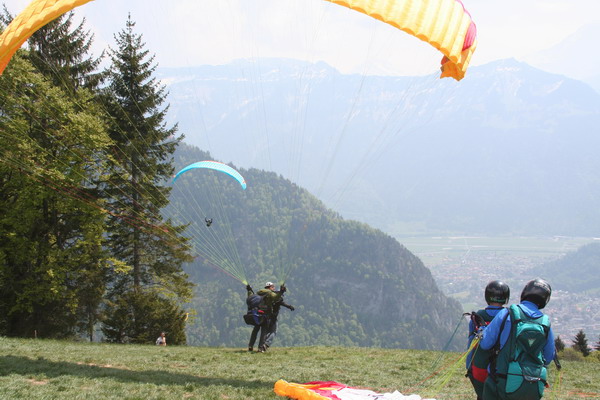
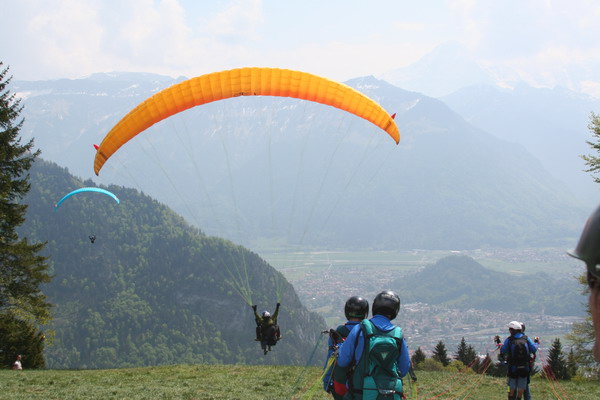
There were plenty of hang gliders launching from the same point.
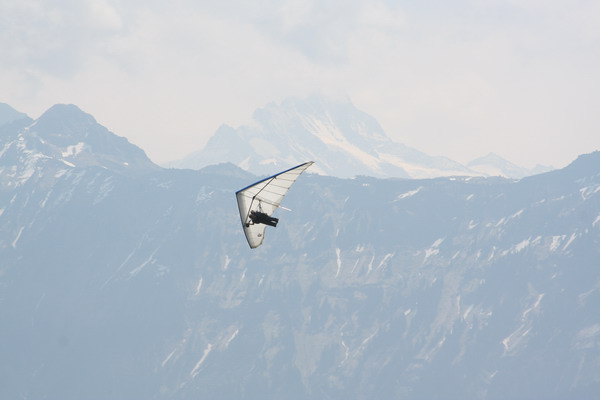
This is an aerial vantage point of the launch point.
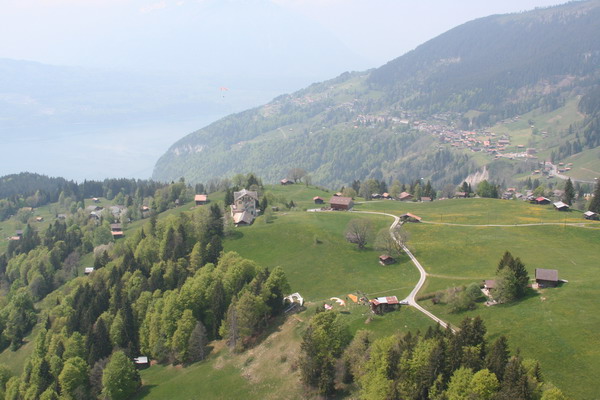
Here is Anna and her pilot flying over Lake Thun (one of the two lakes that surround Interlaken, or “between lakes”).
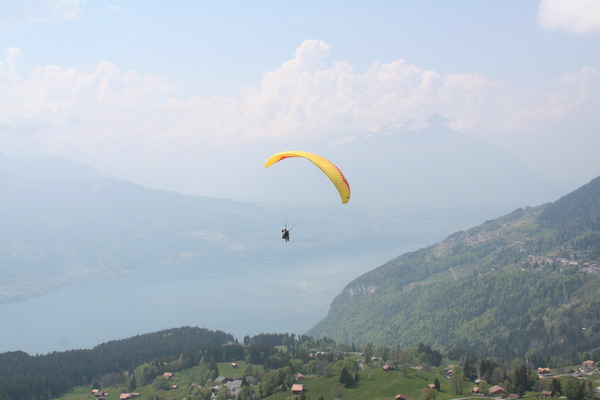
Here’s a solo flier that gives a better perspective of what it’s like.
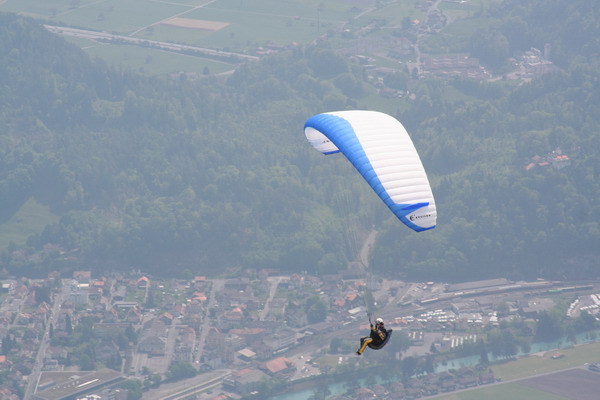
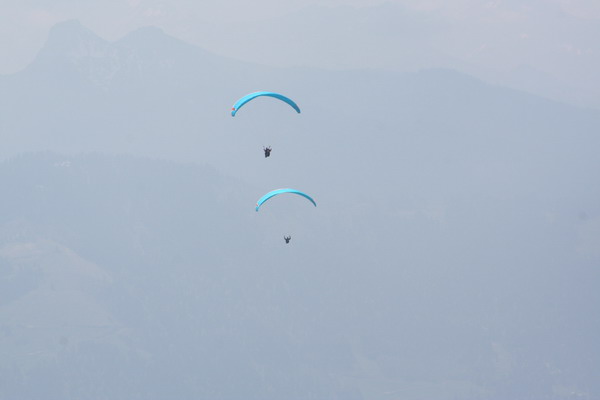
This is Interlaken with Lake Brienz in the background.
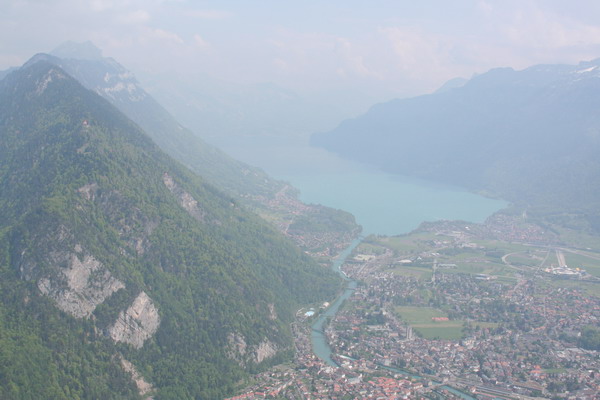
Anna flying high…
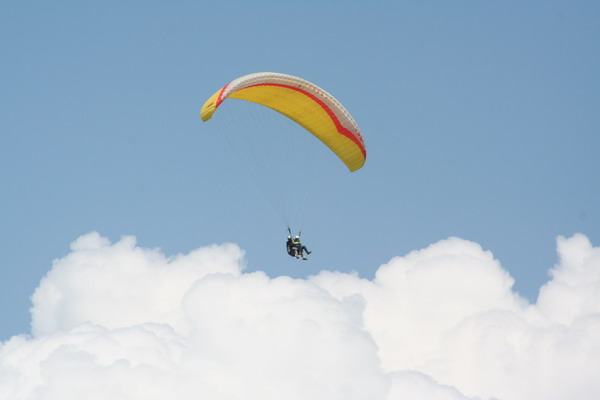
Landing is always the trickiest part, especially when both people are so close together.
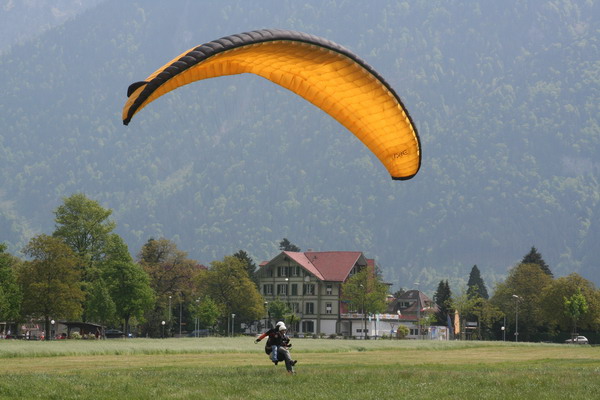
Here’s Anna on short final.
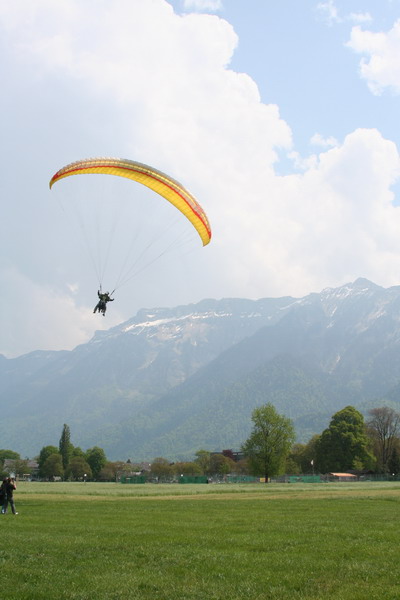
Touchdown.
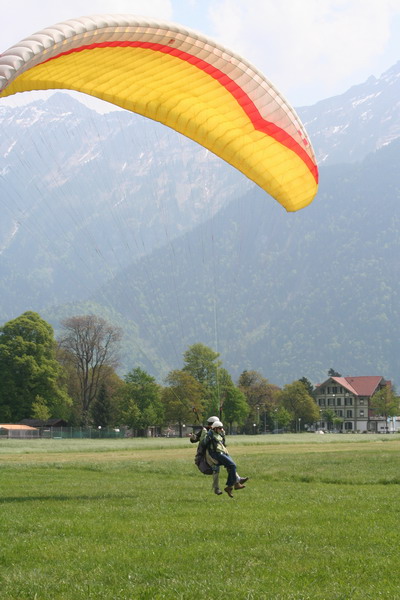
Once back on the ground, she walked away with a little swagger in her step. 🙂
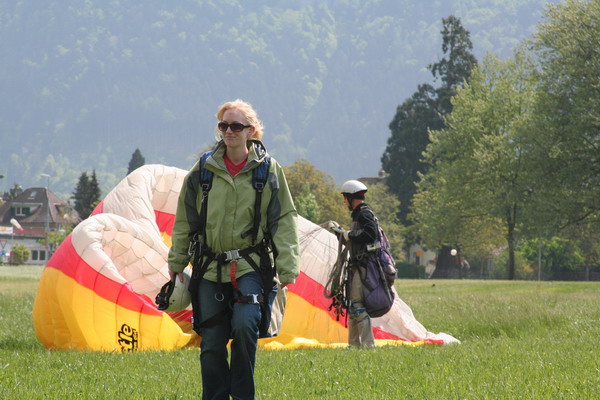
Later, we decided to take a short drive up to the Jungfrau Valley, past the little village of Lauterbrunnen.
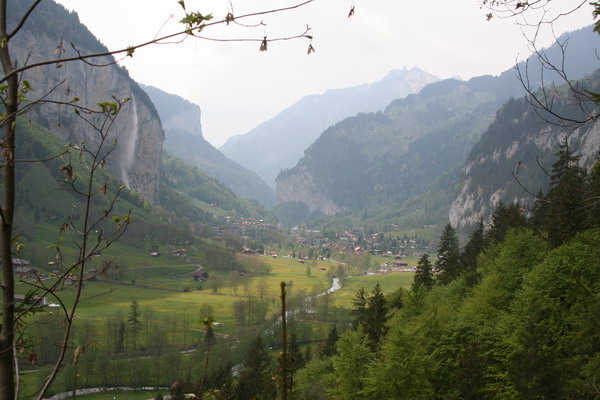
Inside the side of the mountain, erosion from glacial runoff has created a spectacular series of waterfalls. Most are inside the mountain and small tunnels have been cut out of the rock so you can go inside and have a closer look at 10 of these beautiful waterfalls. This is just down stream from the first falls. The water still retains that blue hue of ancient glacial ice.
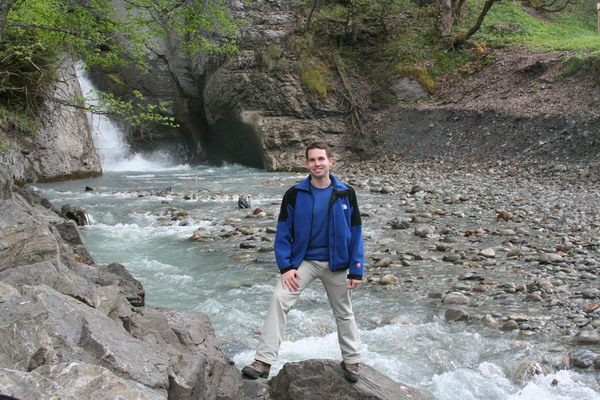
These images are from inside the mountain.
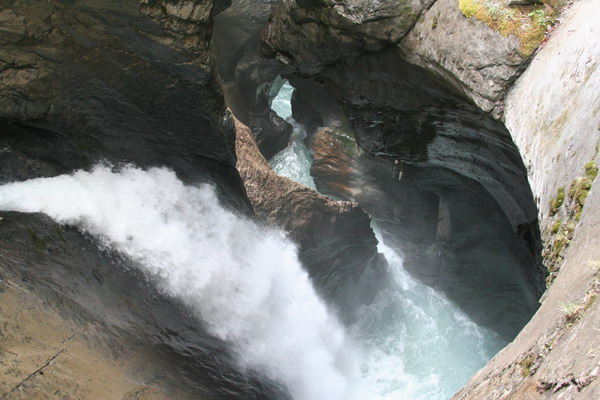
The water courses through the mountain at an average of 100 cubic feet per second (or about 3 cubic meters per second).
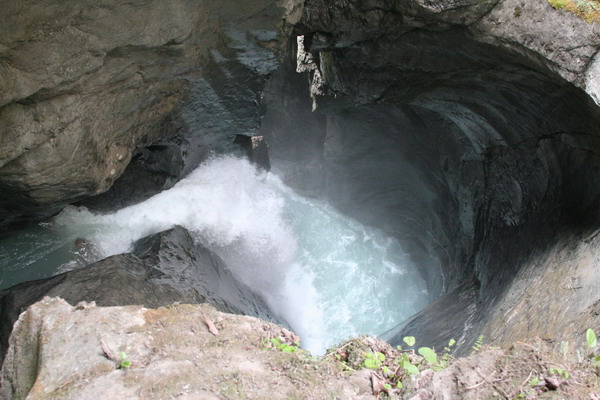
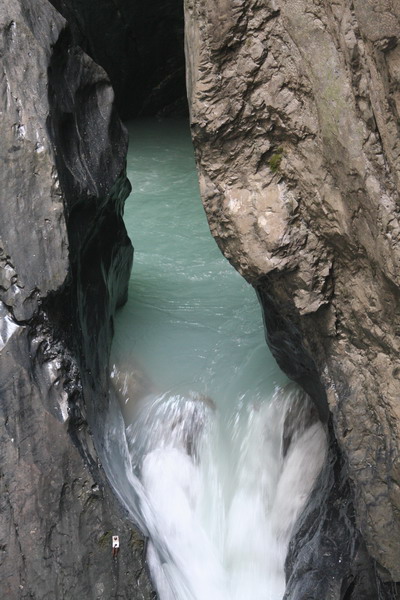
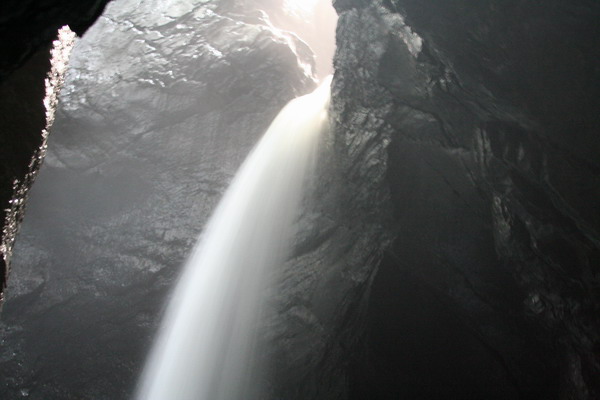
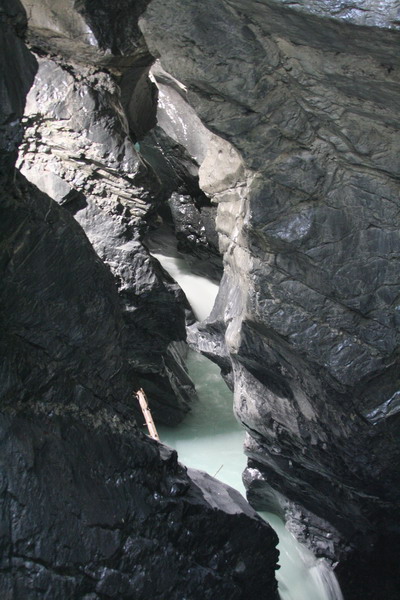
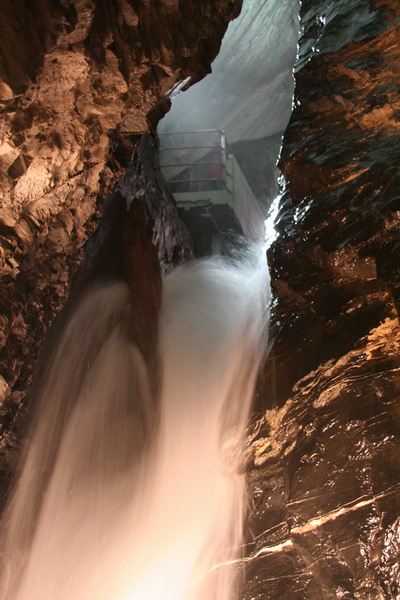
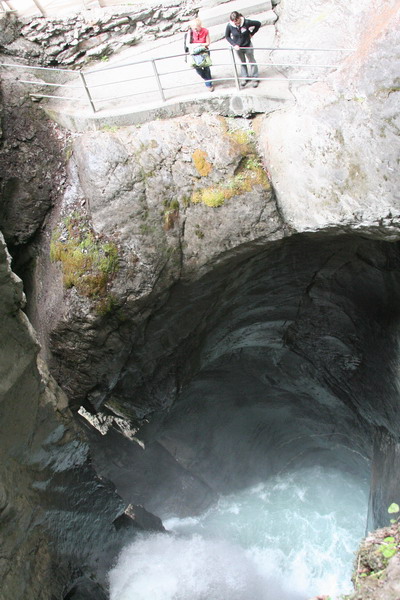

Our next adventure is a fairly new and popular European sport: Canyoning. Since it hasn’t really caught on in other parts of the world yet, let me explain what it involves. Basically you take a group of people (often the younger, “I feel like I am indestructible” types), add a couple of guides, put everyone in thick wetsuits (to ward off the bone numbing cold that comes from glacier fed streams) with life jackets, helmets and finish with a harness, then head to the nearest canyon (with a river or stream in it of course). Next comes the easy part: go from point A to point B in the canyon. Of course getting there is where the fun is. For our canyoning adventure, we hiked across stones, through the water (floating and swimming), jumped off several cliffs (not to worry though, nothing was over 30 feet), slid over natural waterslides into deep pools and rappelled off a cliff in a manner that was more like a zip line than an actual rappel.
As you can imagine, that environment is not conducive to taking pictures. So, all I have is this image from the point where we finished and had lunch.
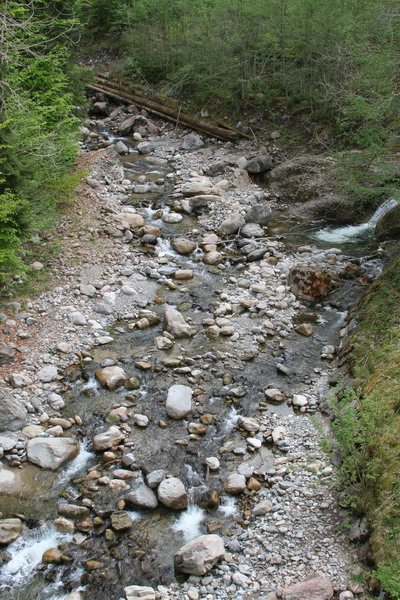
The next stop on our itinerary (and where I am writing this from) is a little town in the Lauterbrunnen Valley called Mürren.
The next post will cover our adventures (hiking), here in this charming Swiss village where cars are not allowed.
So, until then…
–Jim
